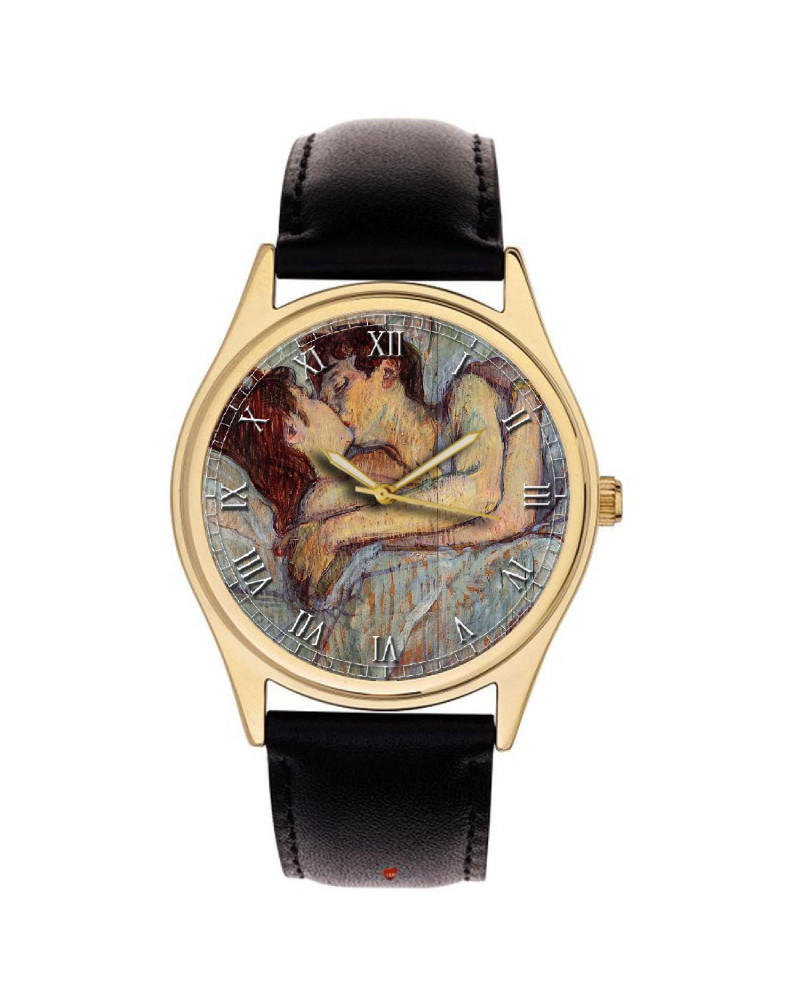




⦿ 40 mm large format Men's size heavy brass case with scratchproof mineral glass crystal and stainless steel back. Also available in silver and titanium black case finishes.
⦿ Premium Citizen 2040 quartz movement, uses easy to find regular watch LR44 batteries.
⦿ Hypoallergenic vegan leather crocodile-print bracelet with matching brass buckle.
⦿ Handmade American pinewood presentation / souvenir / gift box with velvet cushion and brass clasp.
⦿ Unique collectible Limited Edition handmade watches with great investment potential.
⦿ All customization requests will be considered.
Henri de Toulouse-Lautrec, a French Post-Impressionist artist, is renowned for his vivid depictions of Parisian nightlife, particularly the bohemian world of Montmartre’s cabarets, brothels, and dance halls. His work captures the raw sensuality, intimacy, and uninhibited passion of fin-de-siècle France, making him one of the most significant figures in erotic art.
Among his many provocative subjects, Lautrec’s depictions of love, desire, and human connection, including the theme of the kiss, stand out as powerful representations of emotional and physical intimacy. His unfiltered approach to sexuality and deep fascination with Parisian brothels contributed to a unique artistic perspective that continues to influence modern erotic art.
Born in 1864 in Albi, France, Henri de Toulouse-Lautrec came from an aristocratic family but suffered from genetic disorders that stunted his growth after childhood accidents. Unable to participate in traditional aristocratic life, he found solace in art and the nightlife of Montmartre, Paris’s most vibrant artistic district.
Lautrec became closely associated with Moulin Rouge, cabaret culture, and the demi-monde of Paris, portraying the intimate moments of courtesans, lovers, and entertainers with bold lines, striking colors, and a raw, human touch. Unlike his contemporaries, who often idealized their subjects, Lautrec embraced realism, highlighting the emotional and physical aspects of intimacy without romanticizing them.
Lautrec’s portrayal of intimacy is deeply psychological, passionate, and raw. His depictions of kissing lovers, sensual embraces, and lesbian relationships reflect his fascination with human connection. Unlike traditional romanticized depictions of love, Lautrec's kisses often capture the grit, desire, and vulnerability of real-life intimacy.
One of his most tender and intimate pieces, In Bed: The Kiss, captures two women locked in a passionate embrace. This painting is part of his famous brothel series, in which Lautrec documented the private, everyday lives of sex workers—not as objects of male fantasy, but as real women with their own desires and emotions.
The warm, soft palette and fluid brushstrokes give the piece a dreamlike quality, emphasizing the tender yet uninhibited nature of their love. The kiss in this painting is not staged or performative but genuine, deeply felt, and sensual.
This painting showcases a group of women in a brothel, engaging in both sensual and affectionate gestures. Some women kiss, embrace, or lean into each other in quiet moments of companionship, suggesting that Lautrec saw brothels not just as places of commerce but as spaces of genuine connection and human warmth.
Henri de Toulouse-Lautrec’s fearless embrace of eroticism, sexuality, and human intimacy set him apart from his peers. His art influenced generations of erotic painters, photographers, and illustrators, shaping the way intimacy is portrayed in the modern era.
Unlike classical artists who often idealized the female nude, Lautrec brought raw, unfiltered realism to eroticism. His work paved the way for modern erotic artists like Egon Schiele, Pablo Picasso, and Helmut Newton, who explored sexuality with a similar boldness.
Lautrec was among the first mainstream artists to depict lesbian love and affection without fetishization. His work provided an intimate, respectful portrayal of same-sex relationships at a time when they were often hidden from public view.
Lautrec’s close-up compositions, expressive lines, and intimate framing influenced the erotic photography movement, including artists like Man Ray and Helmut Newton. His style is often reflected in cinematic depictions of passion, where shadows, light, and color heighten the emotional weight of a kiss.
Henri de Toulouse-Lautrec revolutionized erotic art by stripping away the fantasy and embracing the authenticity of desire. His depictions of the kiss—whether between lovers, sex workers, or same-sex partners—remain some of the most honest portrayals of intimacy in art history.
By capturing the raw, unfiltered nature of human connection, Lautrec’s legacy continues to shape how artists, photographers, and filmmakers explore love, lust, and the art of the kiss today.